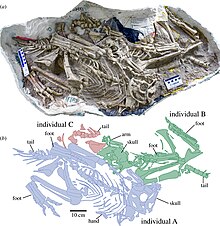Oksoko avarsan
| Oksoko | |
|---|---|

| |
| Holotype block assemblage (top) and line drawing (bottom) | |
| Scientific classification | |
| Domain: | Eukaryota |
| Kingdom: | Animalia |
| Phylum: | Chordata |
| Clade: | Dinosauria |
| Clade: | Saurischia |
| Clade: | Theropoda |
| Family: | †Oviraptoridae |
| Subfamily: | † Heyuanninae
|
| Genus: | †Oksoko Funston et al., 2020 |
| Type species | |
| †Oksoko avarsan Funston et al., 2020
| |
Oksoko (Oak-soak-oh; from
History of discovery

The first specimen of Oksoko, MPC-D 100/33, was discovered in 1974 by the Soviet-Mongolian Palaeontological Expedition at the Bügiin Tsav locality in the Nemegt Formation of Mongolia. It is represented by a partial subadult postcranial skeleton. The holotype specimen is a block of an assemblage of three individuals buried in life positions that has been labelled as MPC-D 102/110.
The first individual, subcatalogued as MPC-D 102/110a, is a partial skeleton of a juvenile preserving the
Another, isolated specimen was collected in 1998 at the Guriliin Tsav locality by a joint expedition from the Hayashibara Museum of Natural Sciences and the Mongolian Palaeontological Centre. It was catalogued as MPC-D 102/12 and represents postcranial skeleton of an adult individual.

This block was in 2006 confiscated from poachers by the General Intelligence Agency of Mongolia along with a fourth specimen, MPC-D 102/11, representing a partial juvenile skeleton preserving the skull. They were later returned to the Mongolian Palaeontological Center on December 14 during the same year, where they were posteriorly prepared by professionals. Though the exact localities of these specimens are currently unknown due to their theft, although the colour of their sediments and geochemical analyses confirm their provenance from the Nemegt Formation.
All of the specimens were later assigned to the new
Although MPC-D 100/33 has been largely referred as a
Description
The
Classification

The describers' phylogenetic analysis places it as a derived member of the subfamily
| Oviraptoridae |
| |||||||||||||||||||||||||||||||||||||||||||||||||||||||||||||||||||||||||||||||||||||||||||||||||||||||||||||||
Paleoenvironment
Oksoko was found in the


